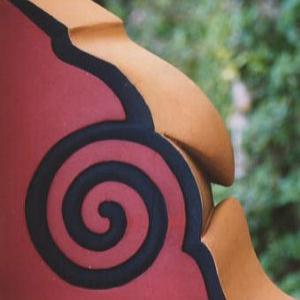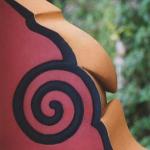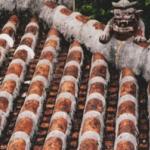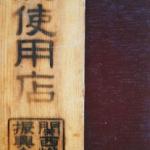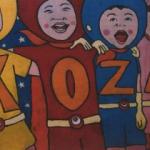A Tale of Two Cities
We are standing shoulder-to-shoulder on a busy corner, looking out at the four lanes of traffic buzzing by; a tall, pale-faced North American next to a short, sun-braised Okinawan. A young islander in blue jeans rushes past us without making eye contact. She is wearing a sky-blue, fitted t-shirt?and printed on the back in sparkling pink letters are the words, "THIS NEW INTERNATIONALL LIVING IS MY FUTTURE."
The smaller man continues with his rich description, "Do you see here? This is where the line used to be, the boundary that divided the Okinawans from the American soldiers on the other side." There was no gate or wall or any other kind of barrier, but as he explained, most people just didn't cross it. "And in the early days it didn't stop there, because the whites and the blacks were also divided down their own half of town. This place got wild sometimes on weekends, they called it the Four Corners, and the tougher guys met for street fights at night, right here in this intersection."
Okinawa City and Gushikawa City are still divided by the same road today, although the highway numbers have changed and most of the meaning that was inherent in the old nicknames has faded over time, like the weathered Coca Cola signs that face out towards the road in this dusty old district. Nowadays most of the younger locals and the American recruits don't know much if anything of the old colorful history, and will probably never take an interest in the stories of Okinawa's past. Which is one of the reasons why I am standing here on this windy curb, starting to sunburn while slouching overtop a stocky Okinawan thirty-five years my senior.
The clapping sound of the man's flip-flop sandals offsets with the squishy, out-of-place sounds of my new running shoes as we wander further down the road. The boundary might still exist today since there aren't any foreigners in sight on this side of town, except for the odd stray serviceman.
Kotaro Iha Sensei is one of the most recognized and reputable modern-day masters of Okinawan weaponry, the ancient art of kobudo. He has trained in the martial arts for almost fifty years, swinging around six-foot wooden staffs, short sickles, nunchaku and a host of other deadly weapons nearly every day of his adult life, sometimes three or four times a day. His legion of students are as likely to have come from Amsterdam or Sydney or Michigan as they are from his own quiet neighbourhood of Taba, now a part of Gushikawa, the same town where he grew up admiring the powerful almost mythical instructors of the generation before him. Even his dojo, a comfortable training hall with every modern convenience, is over thirty years old, reminding me that my seventeen years of training in Okinawan karate only scratches the surface of what there is to be learned here in the birthplace of so many of the martial arts.
"Let's go. It's time to eat. Follow me." Iha Sensei speaks slowly to me and in short bursts of simple Japanese, with the odd word of old Okinawan dialect spicing up his guiding speech. His use of staccato commands, like his rapid gesticulations with his hands and his firm correction of my frequent mistakes, is just the kind of treatment I expected from such a man of the martial arts. What I haven't anticipated are the welcome glimpses into the other side of his martial arts and his personality, softer, humbler images that will emerge as tiny cracks in his stony facade and will eventually characterize most of what he teaches me during my week on Okinawa.
The little toddler sitting next to me babbles on in kid speak while staring right through me with the biggest, brownest eyes I have ever seen in Japan. Her older sister sings a tune from one of the Disney movies, a movie that is her namesake and which she adores as much as any other all-American four-year-old girl. And at the wheel of the compact, reddish-brown station wagon is their father Zane, an eighteen-year veteran and Gunnery Sergeant of the United States Marine Corps. Zane's refreshingly humble, reflecting a life that has taken him all over the world, from his Florida roots to the spitting vipers and sand dunes of Somalia, to Europe and now to the relative comfort of Okinawa. He has devoted many years to the martial arts, training in karate, weaponry, and hindiandi, a rare form of kung fu from southern China. He is one of only half a dozen westerners ever to have learned this deadly striking style.
We have been driving for twenty minutes since we met at a central bus stop on the rundown main strip of Okinawa City, an intersection the American forces call Gate Two where you are as likely to see roving packs of fifteen-year-old American kids in Eminem t-shirts and Yankees caps as you are to see old Okinawans on bicycles. We are in the central region of the main island of Okinawa, an hour north of the capital of Naha, in the heartland of territory occupied by the American Armed Forces, who sixty years after the war still number more than 40,000 over the Japanese archipelago, with three quarters of them on Okinawa. Everywhere I turn there is a token bilingualism, English and Japanese, on street signs and in shop windows, and locals still often refer to this town as Koza, it's old Okinawan name, which is proudly painted on some of the older walls and billboards.
As the main island of Okinawa rushes past me on either side the strongest visions that hit me are the landmarks of American suburbia- Army and Navy Surplus clothing stores, lifeless strip malls, and dozens of Baptist churches offering service in either of the island's adopted languages. There are even A & W Hamburger stands with old-fashioned drive-in booths that vanished twenty years ago in North America. A local driver, a grey haired dwarf of an old man, cuts us off with his tiny white flatbed truck and Zane swings the car around the hazard with clinical caution, without blinking, although his voice lends a hint of anxiety to the situation. "Back home a fender-bender's no big deal but here it's like even the smallest accident is an international incident if it involves one of our guys."
The gate to Camp Foster Marine Corps Base is guarded by two muscular young men in crisp uniforms, one American and the other a member of the Okinawan Guard, a marine security that works in conjunction with the American forces. A lean, black Marine barely out of his teens raises a sharp salute as we pull towards the on-base housing. Immediately a different world opens up all around me- the lanes are wide and are spotted with kids playing catch ball off to the side. There are inflatable plastic wading pools in front of many of the plain detached houses and American flags adorn as many of the front doors and porches of these homes as not. It is the Americana of folklore, like black-and-white television, and old Sears catalogues, and apple pies on windowsills.
Zane and I train in isshin-ryu karate, an Okinawan form popular in North America, and he is riding out his third tour of duty on Okinawa, which makes him about as good of a starting point as any to begin my search for the secrets of the Okinawan martial arts.
Over a home-cooked dinner of barbecued hamburgers, fried chicken and potato salad, Zane introduces me to Kensho Tokumura, a noted instructor of goju-ryu karate in his early sixties. He tells stories at our urging, and once he gets his rhythm, his enthusiasm rolls along like a grandfather spinning tales by the fireside. He talks of the days when martial arts were reserved exclusively for royalty, when first-born sons passed down local styles to the next generation. More fondly he speaks of the rejuvenating days after the war when he stumbled upon Tatsuo Shimabuku, the founder of isshin-ryu karate.
"The dojo in those days was an open courtyard out back behind his house. He earned a contract to teach the Marines and soon enough he had many interested men coming by the house for lessons. Sometimes we trained all day and night. Most evenings his wife would come out to the training hall and serve up his favourite snack in between classes, a cup of awamori (Okinawan rice liquor), topped with a raw egg, called kuga zake that helped relieve his asthma. He would mix it with a chopstick and knock it back in on gulp and then jump out on the floor for the next class."
He smiles with proud eyes when speaking of his old dojo near his home that withstood the annual typhoons for years until he finally knocked down the worn building himself. He jumps up from his seat to punctuate his speech by sitting in a deep horse stance with his knees bent at almost perfect right angles, and breaks into a sudden flood of English, "Okinawan house strong like horse stance. Strong base," he shouts with schoolboy intonation while slapping his thighs with open hands, "makes strong house!" His English is elementary and purpose-built-he is a retired member of the Okinawan Guard and spent many years teaching hand-to-hand combat to elite members of the Okinawan and American forces. He slides a copy of an old karate manual across the table as if it was the morning newspaper and I notice, besides the many grainy black and white photographs of the original masters performing drills and posing in front of their students, that it is a memorial manual dating from 1986, the year I began to study the martial arts in Canada. He mumbles, "presento," before pulling at a barbecued drumstick with a soft, smiling grin.
On the short drive back to my hotel, Tokumura Sensei swings through the small neighbourhood of Taba, on the Gushikawa side where the houses are snug together alongside small shops with only the odd waist-high, stone wall separating the small yards. "This is the house of Iha," he points a single finger towards a two story building. "Top floor is dojo. You go and see him. He teach you weapons."
I am self-conscious, shaking ever so slightly and suddenly feeling every degree of the thick humidity, as I walk up the concrete steps that lead to the second-floor training hall. It has been years since I have asked anyone new to be my instructor, and the anxiety and enthusiasm of a young white belt flows though my body like a shot of adrenalin. His son, like me, in his mid-twenties and standing over six feet tall, is guiding a small class through a series of techniques with the bo, a long wooden staff. He politely greets me and rushes downstairs to fetch his father.
Within the hour we are in the middle of our third or fourth toast, a familiar Okinawan form of expression that is as much social lubrication as it is tradition. The bar is a damp basement club, referred to as a snack in this part of the world, and there is a solitary woman serving the drinks, as resigned and emotionally threadbare as a thousand women doing the same job in lonely clubs all over this chain of islands. She smiles a forced, but almost alluring grin when encouraged, and nods from time to time to punctuate the speech of Iha Sensei. A phone call is made on an old pink rotary phone in the corner and soon a tall, well-tanned man in his fifties shuffles in with a whistle. He is Okinawan, although his jet-black hair, leathery tanned skin and polished white picket fence smile would not be out of place in Las Vegas. I learn that the man, Nago-san, is a renowned player of the shamisen, the Okinawan stringed instrument that is made in part from the stretched skin of the indigenous habu snake. He smiles while spouting out the stories, and he and Iha Sensei laugh and smirk their way though their lines like the old amicable friends that they are. After a couple of nudges from his friend's elbow, Nago-san is on stage playing the instrument and singing the songs that have made him an Okinawan champion with five albums to his name. He sculpts the haunting songs with rigid discipline and an unwavering pitch, to an appreciative crowd of two on a quiet Monday night in this little town a lifetime away from the old circuits. The woman, cheeks flushed from the beer that she has been sipping, joins him on stage for a few of the more somber numbers, singing echoing harmonies and banging out a rhythm on a well-worn cowhide drum.
The next morning I am awakened from a blurry dream by a call from the front desk, and the voice on the other end is unmistakably that of Iha Sensei. "I'm coming for you in five minutes. Bring your camera." It is all that I hear before his voice cuts away to an abrasive dial tone and I scramble up to gather my things.
We are driving along the eastern coastline of this central region, the Pacific side of Okinawa. The coast here features mostly small rundown coves, and there are a number of chain-link fences and wide-lettered warnings not to trespass near the American bases, while the scraps of beach that feature picnic benches and young surfers are few and far between. We stop for lunch in a little fishing village near Camp Hansen, an American Marine base, where a roadside sign in bold black lettering reads, "YOUR CARELESS WAYS ARE CAUSING MANY DEATHS!"
Iha Sensei was born in 1939, the youngest of four children, of a generation whose earliest memories were punctuated by the aftermath of war and the blur of redevelopment under American occupation. He drives me to the site of his old family home, where his brother still has a house nearby, and we find him busy tending to a packed greenhouse of prize-winning bonsai trees. The marshy Tengan River that hugs the property line is the canvas to yet another vivid memory. "We used to fish there every day when I was a young boy," he said pointing out along the emerald green bank, "We'd pull out eels four or five feet long, the odd silverfish and even little striped frogs. Good eating in those days".
I struggle to pull my heavy starched uniform over an aching sunburn that must cover fifty percent of my body, and I reach down to bandage a few of the worst blisters earned over the week's touring. It's just past midday, and when I crack open the change room door, I find half a dozen older women out on the floor frowning down at me like scolding librarians and motioning towards the clock. A stern looking woman yells out, "Hurry up!" and I race to join the end of the line before we begin the series of bows that start the class. The six students are between the ages of fifty-five and sixty-five. All are grandmothers and wrapped around each powerful set of hips is a black belt in Okinawan weaponry.
Iha Sensei smiles from the corners of his mouth as I sweat and grunt and generally fail to grasp any of the techniques being taught to me. We run through traditional forms- the beautiful, almost dance-like kata. Each kata was once the showpiece of a particular region or town, as distinctive as a folk song or a pattern of cloth. Today these stocky women, hair pulled back in tight ponytails and well over twice my age, hardly break a sweat in the mid-afternoon heat as they flow through the motions with complete fluidity, without a hint of effort. I am familiar with a few of the weapons, having studied some for over a decade, and yet I have never seen such simple power created by such perfect form. After watching many hopeless attempts with arms folded in silence, Iha Sensei takes pity on me and guides me privately through the techniques of the long wooden staff. He speaks only out of necessity, preferring instead, it would seem, to lead by example, and as I strain to follow every change in stance, every shift in balance, I feel my confidence build and know that I have made the correct decision in training with this unique and talented man.
Over the next seven hours I see students from as young as six years old swing nunchaku, sai (three-pronged iron truncheons), and a host of other traditional weapons around like plastic toys. Although sometimes only centimeters apart, they manage to avoid so much as grazing each other's uniform. Later that evening, walking back from the dojo after class, he reaches up towards a branch hanging down over his property from the neighbouring yard. The small fruit he offers up from the palm of his hand are the roe-colored acelora cherries, tart and delicious and the size of small marbles. "Okinawa size," he says with a smile.
On my last morning in Gushikawa, Iha Sensei takes me to eat at a stand near his house, where we poke at steaming bowls of flat Okinawan soba noodles with thin slices of mint green, bitter goya on the side. He unrolls a sheet of textured rice paper filled with Chinese characters brushed in elegant strokes, black on white. A finger pointed towards himself tells me that he is the author of this, a poem written in the traditional style of ryu ka, an Okinawan cousin of haiku. He describes each character as others might explain photos of their grandchildren, with loving care and an intimate knowledge. His poem is about the blossoming deigo, a crimson flower that rises to full bloom even after enduring the worst of the rainy season.
After lunch, he insists on driving me back to Naha, past the alternating stretches of American and Okinawan life that blur together along the boundaries. In front of the hostel where I will spend my last night on Okinawa before flying back to my life in mainland Japan, he offers me a hand with my heavy backpack. I turn down his request with a polite phrase of Japanese and instead sling it over my shoulder before stepping up to the curb. As I turn around to say goodbye one last time he is back sitting in his car, rolling down the window on the passenger side. He leans out with a wide smile and shouts, "Canadian size" before waving gently and driving of back down the road to Gushikawa.
* * * * *
The author would like to thank Mr. A.J. Advincula and Mr. Zane Legg for their incredible support.
* * * * *
 ThingsAsian
ThingsAsian